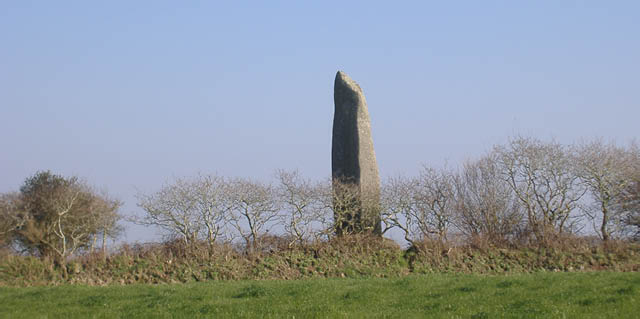
La Bretagne terre des
mégalithes :
Riche et diversifié, le patrimoine
archéologique breton est surtout connu pour ses monuments
mégalithiques. Edifiés au néolithique, les imposants menhirs se
dressent par milliers sur certains sites bretons : lieux de
sépulture ou de rassemblement, points de repères astronomiques ou
bornes marquant la séparation entre deux mondes? Leur signification
demeure incertaine, de même que la façon de les aborder. Beaucoup
reste à découvrir……
Kerloas, le plus haut bien
que décapité :
Il s’agit du menhir (terme construit à partir du breton maen,
« pierre », et hir, « longue ») le plus grand actuellement
debout.
Géologie et
histoire :
La roche
constituant le menhir de Kerloas est un granite porphyroïde à très
gros feldspaths roses (orthoses essentiellement) et micas noirs
(biotites). ce granite qui comporte des petites enclaves endogènes
allongées de teinte gris-noir, à grain fin, est connu sous le nom
de granite de l'Aber-Ildut. Ce granite est réputé pour sa couleur
rosée (due à la présence de particules microscopiques d'hématite
dans les orthoses), et sa résistance à l'altération.
Détail du granite de l'Aber
Ildut : Il a servi à la construction de phares, de bâtiments
publics ou privés, de forts et, en 1835, on l'utilisa pour former
le socle de l'obélisque de Louqsor à Paris.
Au Néolithique, la plupart des mégalithes (dolmens et menhirs) de
la région de Porspoder ont été construits avec cette roche.
La carte géologique révèle que le substratum du site d'implantation
du Menhir de Kerloas est formé par le granite de Saint-Renan,
granite à grain fin au sein duquel existent des formations
stanno-wolframifères. L'érosion de ce granite est à l'origine des
gîtes alluvionnaires de cassitérite (minerai d'étain).
L'affleurement de granite de l'Aber Ildut le plus proche de Kerloas
est distant de 2 km et il est raisonnable de penser que les hommes
du Néolithique ont transporté le bloc sur une distance de plusieurs
kilomètres, ce qui ne fut sans doute pas une mince
affaire.
Caractéristiques :
Sa hauteur
au-dessus du sol naturel est de 9,50 m. En effet il faut faire
abstraction de 0,30 m de terre rapportée, il y a quelques années,
pour pallier l'érosion du sol provoquée par le piétinement des
visiteurs. Cette érosion avait eu pour effet de mettre au jour les
pierres de calage du menhir.
Cependant, la hauteur originelle de ce monolithe était bien plus
importante et devait dépasser les 10 m car, au XVIIIème siècle, il
fut victime de la foudre qui en tronqua la partie sommitale et les
principaux morceaux qui gisaient à son pied furent utilisés, l'un
pour la fabrication d'une auge, l'autre comme pierre d'entrée de
champ. Cette dernière a été reconvertie aujourd'hui en ornement de
pelouse à la ferme voisine.
La
circonférence du menhir, au niveau du sol, est de 6,20 m ; à 1,20 m
de hauteur elle est de 6,70 m ; à 3,65 m elle est de 6,96 m, puis
la pierre devient plus fine ; à 5 m, la circonférence est de 6,45 m
et à 6 m elle passe à 5,95 m.
Le poids du menhir est estimé à 150 tonnes.
Légendes :
Sous son pied
un trésor serait caché, visible uniquement pendant la nuit de
Noël….
La légende dit qu’au premier coup de minuit, les menhirs
couraient s’abreuver dans l’océan. Mais lorsque sonnait
le douzième coup ils avaient déjà repris leur place, stoïques,
immobiles, insensibles aux attaques du temps. Malheurs aux
imprudents qui, éblouis par les richesses dévoilées, avaient oublié
l’heure, ils étaient écrasés…
Validation :
Pour valider
votre découverte vous devrez joindre une photo de vous ou de votre
GPS devant le menhir et m'adresser un mail indiquant ce que masque le carré rouge sur le
panneau descriptif (que vous ne pouvez manquer) sur la photographie
N°1.
Beaucoup plus de détails
sur kerloas sur la page web dédiée figurant en haut du listing et
dont je me suis inspiré.
http://www.wiki-brest.net/index.php/Menhir_de_Kerloas
Kerloas, the granite giant.
Brittany is in hiding megaliths:
Rich and diversified, the Breton
archaeological patrimony is especially known for its megalithic
monuments. Built in the neolithic, the impressive menhirs raise
themselves(draw up themselves) by thousands on certain Breton
sites: places of grave or assembling, astronomical landmarks or
borders marking the separation between two worlds? Their meaning
remains vague, as well as the way of approaching them. A lot rest
to be discovered …
Kerloas, the highest although
beheaded:
It is about the menhir (term builds
from the Breton maen , "stone", and hir, "long") the biggest at
present up.
Geology and history:
The cliff establishing(constituting)
the menhir of Kerloas is a granite porphyroïde in very big pink
feldspars (orthoses essentially) and black micas biotites ). This
granite which contains small endogenous enclaves
lengthened(stretched out) by tint grey-black, in fine grain(bead),
is known under the name of granite of Aber-Ildut. This granite is
considered as its pinkish colour (due to the presence of tiny
particles of hématite in orthoses), and its resistance in the
change.
Detail of the granite of Aber Ildut: he(it) was of use to the
construction of lighthouses, of public or private buildings(ships),
strong and, in 1835, we used him(it) to form the pedestal of the
obelisk from Louqsor to Paris.
In the Neolithic, most of the megaliths (dolmens and menhirs) of
the region of Porspoder were built with this cliff.
The geologic card reveals that the substratum of the site of
setting-up(establishment) of the Menhir of Kerloas is formed by the
granite of Saint-Renan, the granite with fine grain(bead) within
which exist stanno-wolframifères formings(trainings). The erosion
of this granite is at the origin of shelters alluvionnaires of
cassitérite (ore of tin).
The emergence of granite of Aber Ildut the closest to Kerloas is
distant from 2 km and it is reasonable to think that the
men(people) of the Neolithic transported the block on a distance of
several kilometres, what was not doubtless a small
matter.
Characteristics:
His(Her,Its) height over the natural
ground is 9,50 m. Indeed it is necessary to disregard 0,30 m of
brought back(reported) earth(ground), some years ago, to mitigate
the erosion of the ground provoked by the standing about of the
guests. This erosion had had the effect of bringing to light stones
of wedging of the menhir.
However, the original height of this monolith was more important
and had to exceed 10 m because, in the XVIIIth century, he was a
victim of the lightning who truncated the sommitale part(party) and
the main fragments which gisaient in his(her,its) foot were used,
the one for the manufacture of an auge, the other one as the stone
of entrance(entry) of field. This last one was reconverted to
ornament of lawn to the firm neighbour today.
The circumference of the menhir, at ground level, is 6,20 m; in
1,20 m of height she(it) is 6,70 m; in 3,65 m she(it) is 6,96 m,
then the stone becomes finer; in 5 m, the circumference is 6,45 m
and in 6 m it pass in 5,95 m.
The weight of the menhir is estimated at 150 tons.
Legends:
Under its foot a treasure would would
been hidden, visible only during the night of Christmas.
The legend says that in the first blow of midnight, menhirs
ran(roamed) to drink in the ocean. But when the twelfth blow rang
they had already resumed their place, stoical, immovable,
insensible in the attacks of time. Misfortunes to the foolhardy
persons who, dazzled by the revealed wealth, had forgotten the
hour, they were crushed …
Validation :
To validate your discovery you will
have to join a photo of you or your GPS in front of the menhir and
send me a mail indicating what masks the red square on the
descriptive panel (that you cannot miss) on the photography
N°1.
Many more details of kerloas on the dedicated web page appearing in
the top of the listing and by which I was inspired.
http://www.wiki-brest.net/index.php/Menhir_de_Kerloas
| I am a proud |
 |